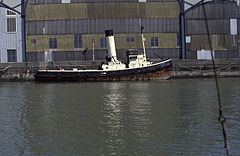Type Private company Fate Closed | ||
 | ||
Headquarters Hessle, East Riding of Yorkshire, England | ||
Highlight tape richard dunston
Richard Dunston was a shipbuilder on the Humber, England. The company started building wooden barges miles from the sea and evolved to pioneer fully welded steel ships of a single design. The yard is now closed, although the name continues in a ship repair yard.
Contents
History
Before 1858, Richard Dunston owned a boatyard at Torksey on the Foss Dyke, but in that year he sold the yard, and established a new one at Thorne, on the north bank of the Stainforth and Keadby Canal. It was 12 miles (19 km) from the River Trent, and some 45 miles (72 km) from the sea. He built wooden barges, using locally-grown, hand-sawn timber. In common with many boatyards at the time, Dunston's was self-contained, with facilities for making sails, ropes and running gear. This developed into a profitable sideline, supplying ropes to many local industries, and other items to chandlers based at Hull and Grimsby. While repairs to existing hulls were a major part of the output of the yard, vessels capable of carrying up to 80 tons were built, for use on the Humber and its connecting navigations. The hulls were initially clinker built, using overlapping joints between the timbers, but later carvel construction was used, where the timbers butted up against each other to produce a much smoother hull. By the end of the nineteenth century, boat sizes had standardised somewhat, with most craft being either Sheffield-sized keels with square rigging, or larger Humber sloops. Sheffield-sized boats were 61.5 by 15.5 feet (18.7 by 4.7 m). Output was fairly low, with an average of one and a half vessels per year between 1858 and 1914, although a celebration was held when the third vessel in one year was launched.
In 1902, control of the yard passed to Thomas Dunston following the death of his father, and in 1910 to the 20-year-old grandson of the founder. He set about modernising the business to enable the construction of iron and steel ships, the first of which was completed in 1917. New buildings were erected, and new plant was installed to cope with the new method of construction, after which only one further wooden vessel was built. It was supplied to a carrier based at Owston Ferry, was named Constance, and was completed in 1925. The size of vessels that could be built at the Thorne site was limited by the size of Keadby lock, which was 79.5 by 21.5 feet (24.2 by 6.6 m). Because it connected to the tidal River Trent, ships which were longer than this could pass through when the river was level with the canal, and both sets of gates could be opened, but the width was restricted to about 21 feet (6.4 m).
Dunstons bought the Henry Scarr shipbuilding yard at Hessle in 1932, which allowed ships to be launched directly into the Humber. They pioneered construction of all-welded ships in the UK, finding that they could mass-produce a single design more efficiently than traditional riveting. During the Second World War they designed the all-welded steel TID class tug, and built 159 of them, 152 at Thorne and seven at Hessle, with one completed ship leaving the shipyard at six-day intervals. Sections were fabricated elsewhere by companies with spare welding capacity, and were brought to the yard by lorry. Eight sections were needed to make a complete tug, and many of the shipyard welders were women.
In 1974 the Dunston family sold both yards to the Ingram Corporation of America. In 1985, they were put up for sale again, but the Thorne yard closed as it was not financially viable. The Hessle yard was the subject of a management buy out, funded by Dutch capital (?Damen Shipyards Group). Following this, the yard built a variety of vessels, including four Clyde car ferries, a low air draft dry cargo ship, gas tankers and naval tugs.
In December 1994, the company went into liquidation and the Hessle yard closed. It was used as a recycling yard for several years following its closure, but most of the site has now been rebuilt with offices and car showrooms. Richard Dunston ship repairs still exists further east along the Humber Estuary.
Ships built
Records of the ships built before the 1930s are not comprehensive, but after 1932, Dunston's built 1358 vessels at the Thorne yard and 636 at Hessle.
Hessle
Sources: Ships Photos and Historic Ships RegisterThorne
Sources: Historic Ships Register and Taylor 2009.Boats in active service
The following ship is for sale in November 2015. The last name was MV Togo, registered in The Netherlands and is a beauty.
